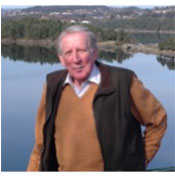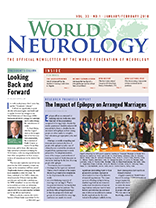Richard Bertram Godwin-Austen came from an illustrious English family. His ancestry can be traced to the reign of Richard II in the 14th century. His 19th century ancestors included two Fellows of the Royal Society, Robert Alfred Cloyne and Henry Haversham. The latter extensively surveyed the Karakoram region of the Himalayas establishing the height of K2 (for a while known as “Mt. Godwin-Austen”).

Richard Bertram Godwin-Austen
Richard was born in 1935, and during World War II, his father was posted as a surveyor for the colonial office in Cyprus. Richard and his brother were sent to South Africa for the period of the war. He returned to England in 1945 and was sent to a boarding school. He started his medical studies at St. Thomas’s hospital a few years after the establishment of the British National Health Service. He qualified in 1959 and did his early training in St. Thomas’s hospital in London.
Richard decided to train in neurology. In 1961, he married his first wife Jane. He did some of his early training in Exeter, returning to London in 1963. He worked with Michael Kremer at the Middlesex Hospital and Roger Gilliatt at Queen Square. Gilliatt was the son of the Queen’s obstetrician and fought in the Italian campaign and was awarded an MC. He had great power over British neurology for decades.
There were few consultant neurologist posts in the 1960s. At the time, Richard was working at the National Hospital as a senior registrar. In 1970, Michael Harrison (later professor) suggested to Richard that he should apply for a consultant post in Nottingham.
Harrison had already applied for the post, as he previously worked with the senior physician in Nottingham and they both thought it would be a good experience for Richard to attend a consultant interview. To the surprise of all, Richard was offered the job. He then spent all of his professional life in Nottingham.
In June 1996, he had to face a life-changing tragedy. He and his wife were involved in a terrible car accident, in which Jane died. Richard was devastated by the loss, badly injured himself, and soon after had to consider early retirement.
The relationship to the WFN started when Richard attended the World Congress of Neurology Kyoto 1981. He presented the first clinical paper on MRI imaging of six patients. The chair of the session moved the presentation forward, as the previous presenter did not attend. When Richard finished the presentation, the hall filled up and the chair was asked if Richard could present the paper again, which he did.
This was probably the first and only time that a paper was repeated in a World Congress. One has to mention that Bill Moore, a young physicist in Nottingham, conducted the initial research into the clinical application to create an image using magnetic resonance. The safety of the technique was tested on an onion, his wrist and his head. The other two involved were Peter Mansfield and Godfrey Hounsfield. Peter Mansfield received the Nobel Prize for his work; he died in 2017.
The Secretary-Treasurer General of the WFN is the dynamo of the Federation. Frank Clifford-Rose’s two terms in the post were coming to an end. Richard was asked to apply, and he was elected during the Buenos Aires WCN 1997. He served two terms, including a most successful WCN in London 2001. During that time, he worked tirelessly to organize the London office with the help of Keith Newton, the WFN administrator. He worked mainly with James Toole and Jun Kimura as WFN presidents. As the Secretary-Treasurer General term overlaps, he also worked with John Walton and Johan Aarli. These were formative years for the WFN when the basis of training centers and programs were initiated.
Meanwhile in 1997, Richard married again. He had known his second wife Sally since the 1950s. She had moved to the United States, and their paths had separated before his first marriage. By serendipity, they met again, and he found new happiness.
His involvement with the WFN continued until less than three months before his unexpected death. Richard presented a fantastic paper on “Nottingham and the Early Days of MRI Scanning” at the XXIII WCN in Kyoto in September 2017. The paper focused on the ideas (the Eureka moments), which contributed to the developments.
He and his wife Sally enjoyed their trip to Japan, and they met many friends in the World Congress. His involvement with the WFN started and ended in Kyoto, spanning a period of 36 years.
In the late 1960s, Richard was involved in research in Parkinson’s disease, and his book ‘The Parkinson’s Disease Handbook” has been a major resource for patients and their families. He was elected president of the Association of British Neurologists 1997-1999, vice president of the European Federation of Neurological Societies, as well as serving on the council of the Academy of Experts, the European Board of Neurology, Parkinson’s Disease Society, and the Nottingham Medico-Legal Society.
Of huge interest to his international friends was his appointment as the High Sherriff of Nottinghamshire. He was an enthusiast for whatever he did, whether it was in the field of art, music, fishing, dancing, Chinese snuff bottles or Japanese ceramics, or the paintings of David Bomberg, of which he owned a few.
His memoirs “Seizing Opportunities: The Reminiscences of a Physician” is a most delightful read for all to enjoy. His character was that of a true gentleman and has always been a loyal friend to all who knew him. He will certainly be missed.
Richard passed away suddenly on Dec. 3, 2017, at the age of 83 years. He is survived by his wife Sally, two children Jonathan and Alice, six grandchildren, and three stepsons.
Prof. Raad Shakir served as president of the WFN from 2014-2018.
